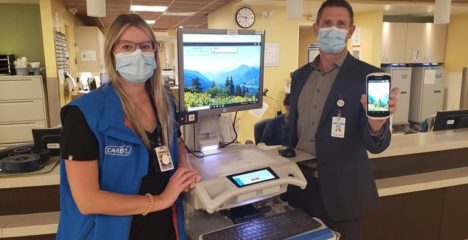Our Excellence
Drive Clinical Excellence
We will focus relentlessly on safety and quality, developing specialized clinical services so people throughout Simcoe Muskoka can receive the best care close to home.
Imaging Technology at RVH Advances Patient Care
Previous Stories from 2021-2022 Annual Report
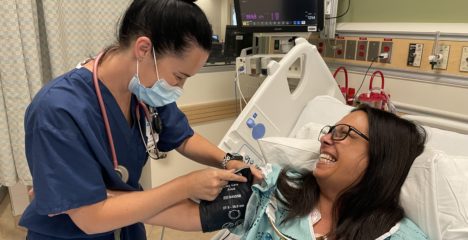
Sue Talampas, 56, says the Rama Paramedics and the advanced cardiac team at RVH are super stars for the gold standard of treatment she received after suffering a recent heart attack.
The Township of Ramara resident was getting ready for her shift at Casino Rama when intense pain hit her in the neck, chest and arms. Thinking it was just a result of existing chronic back pain she was all set to wait it out. Then she started sweating profusely and that’s what set off the alarm bells.
“I knew then that something different was happening. Something was really wrong and yet I never thought I was having a heart attack – it didn’t cross my mind,” says Talampas.
But she was, indeed, having a heart attack that would require immediate angioplasty and the insertion of two stents.
Talampas’ husband Misael called 911 and was instructed to give her two Aspirin. Upon arrival and after assessing, the paramedics enacted the Code STEMI protocol which saw Talampas transported directly to RVH’s Cardiac Intervention Unit for her lifesaving treatment. This gold standard of care is achieved when a patient receives.
Heart attack patients across the region now have access to the gold standard of care – advanced cardiac care in 120 minutes or less after first medical contact – thanks to the Simcoe Muskoka Code STEMI Protocol, first introduced to the county and Rama First Nation in November 2020. This protocol was gradually expanded throughout the region and is a partnership between RVH, the County of Simcoe Paramedic Services, Rama and Muskoka Paramedic Services and area hospitals.
This protocol means that most residents with heart attack symptoms who present to an Emergency department or who call 911 are taken directly to RVH where the advanced heart team is waiting for them.
“We are incredibly proud of the hard work and dedication of our paramedics everyday, and we have been excited to bring advanced cardiac care to the residents of Rama First Nation and surrounding area. Our paramedics have worked diligently for years perfecting their clinical practice to ensure that our patients receive the highest level of care,” says Ryan Kingsborough, Paramedic Superintendent, Chippewas of Rama First Nation.
RVH’s regional heart program opened in January 2018 and since then the cardiac team has completed 10,838 heart procedures including angiograms, angioplasty and pacemaker implants.
“Having these advanced cardiac services, and a highly-skilled team at RVH, means the majority of patients in the region will be able to get lifesaving intervention within 120 minutes of a heart attack,” says Dr. Tony Lee, medical director of RVH’s Cardiac Intervention Unit. “This new cardiac protocol would not be possible without the full collaboration of all our health partners in this region.”
It is this collaboration that has Talampas singing her care team’s praises.
“I was impressed with how everything went so smoothly, from the two great female paramedics to my care in RVH’s Cardiac Care Unit following my procedure,” says Talampas. “I have always supported the establishing of advance cardiac care at RVH through Bell Media’s 104.1 The DOCK and PURE Country 106 Radio for Cardiology Radiothon, never thinking I’d be the one using the service. Now I’m feeling so grateful for it”.
It is important to know the signs of a heart attack: chest pressure, sweating, neck and jaw discomfort, nausea, shortness of breath or light-headedness. Anyone who thinks they may be having a heart attack should immediately call 911.
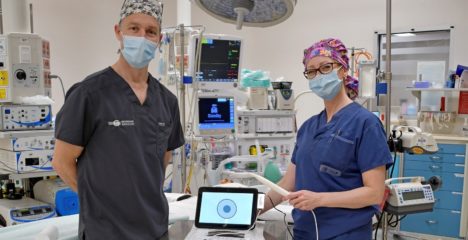
RVH is the first regional health centre in Canada to adopt a precise, easy-to-use new technology for breast cancer that gives surgeons more flexibility and radically improves the patient experience.
Until now, a lumpectomy procedure, for example, involved inserting a wire into the breast at the location of the lump. The protruding wire was not only uncomfortable for the patient, but staff would often be jabbed by it and the wire would remain sticking out of the breast until surgery.
The new MOLLI technology removes the need for a localization wire. Thirty days before surgery, a radiologist locates the lump and implants a MOLLI Marker into the breast. During the surgery a MOLLI Wand detects the marker and visualizes its location on a tablet, helping surgeons locate lesions more efficiently with improved accuracy. This technology has also been designed to be compatible with conventional mammography and ultrasound imaging, facilitating a smooth transition into hospitals.
Dr. Renee Hanrahan, RVH’s Deputy Chief of Surgery and a Canadian leader in oncologic and oncoplastic/reconstructive breast surgery, was one of the surgeons who trialed the technology at RVH and is an advocate of the new MOLLI technology.
“About 80 per cent of breast cancer surgeries are performed outside of academic centres and take place mainly in hospitals like RVH,” says Dr. Hanrahan. “Having a technology that is easy to implement and is inherently easy to learn makes it simpler and faster for surgeons to incorporate it into practice. MOLLI is not only intuitive, but it also allows for greater precision when choosing an incision site, which is important for both an oncologic and aesthetic outcome and an efficacy standpoint. MOLLI also creates flexibility and efficiency in scheduling surgeries, which helps to ease surgical backlogs.”
Most importantly, MOLLI gives patients a better surgical experience. “This is a great benefit for women as it allows for convenient timing of marker placement when it best suits our patients,” says Dr. Drew Schemmer, Medical Director/Chief of Medical Imaging. “Surgeons are able to determine the most aesthetically pleasing approach to remove the target within 30 days of their surgery.”
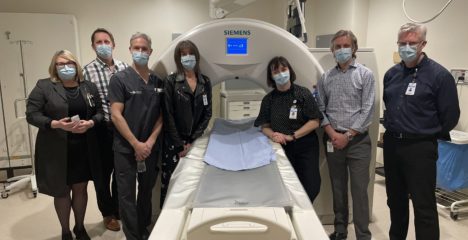
RVH is about to add one of the most powerful and advanced tools for early and more accurate cancer detection to its diagnostic arsenal — a PET-CT scanner.
A PET-CT scan is a painless and non-invasive procedure that gives doctors a clearer, more precise look inside the body at its molecular level.
The PET part, which stands for Positron Emission Tomography, involves first injecting the patient with a very small and safe amount of a radioactive substance called a radiotracer. Diseased cells in the body absorb more of the radiotracer than healthy ones do, so, during the scan itself, the machine detects the radiation (now in the cancer cells) and produces images of the affected tissue.
The CT, or Computed Tomography part of the machine, takes a series of X-rays all around the body and puts them together to make a 3D image. The PET-CT combines the images and gives doctors an excellent picture of what’s really happening inside the patient.
Dr. Drew Schemmer, RVH Chief of Medical Imaging, explains “The scan helps radiologists see exactly where cancer is located. It helps us find certain diseases earlier when they may be more treatable, gives us information to devise the best treatment plan possible, and it can show us how well a patient’s treatment is working.”
Introducing a PET-CT has long been part of RVH’s strategic plan. In fact, a room in the Medical Imaging department was built for a PET-CT during the expansion ten years ago.
The PET-CT will be operational by Fall 2023. There are still a few steps complete: renovations must be done to shield the walls with lead to ensure protection from radiation exposure, the machine itself must be procured and installed (no easy feat considering the four-tonne weight of the equipment!), numerous safety checks need to be executed, and staff will require time for specialty training and certification.
Currently, approximately 600 Simcoe Muskoka patients must travel to Toronto for this highly-specialized scan. Once installed, having the PET-CT scanner closer to home will be a game-changer for Simcoe Muskoka cancer patients.
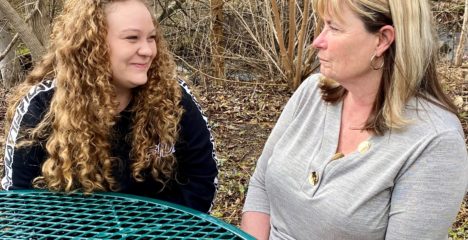
Duncan’s dance with drugs dragged him away from a beautiful life and threw him into a jail cell, a place he would continue to visit regularly for over a decade.
The 40-year-old Barrie man never touched drugs until he suffered a back injury that required pain medication. Once his back healed, his addiction remained and drove him to extreme measures for that daily fix.
“I’m the kinda guy who doesn’t like to feel. Alcohol was my way to numb out, but that was until the slipped disc in my back. After that, I used drugs every day. I’d wake up and reach for the pills and that could continue up to ten times a day.”
And it didn’t matter how he got his drugs either. He’d steal, get them from local dealers and even buy them from seniors selling their own pain medications just to get by.
During the next decade Duncan would become a familiar face in the Barrie jail as his life spiraled out of control. He was now broke, alone and homeless. Sleeping on his mother’s couch, he was ready to end it all.
Adrienne, 26, knows this path all too well.
Coming from a family background where addictions were rampant she fought the drug demon until one day it overpowered her.
“You wake up and nothing makes you happy until to get your fix. It becomes integrated into your morning routine, like a morning coffee,” says Adrienne. “You never have a clear mind and I always felt like I was walking around like a zombie and yet I was never satisfied. I had to have more and more.”
She too got her drugs from the streets or from people willing to sell their prescriptions to her.
“I was a mess and my biggest fear was losing my children.” A fear that proved to be the catalyst for her to finally seek help.
Adrienne and Duncan were literally at the end of their ropes when they both found acceptance, support and eventually freedom from the bondage of addiction. That’s because they were brave enough to walk through the doors of RVH’s RAAM clinic (Regional Rapid Access Addiction Medicine) in Barrie. This is one of four regional walk-in clinics (Barrie, Orillia, Midland and Wasaga Beach) designed to provide immediate help for people struggling with addictions.
“The RAAM clinics make it easier for individuals and their families to get the help they need when they are ready to make a change because no referral or appointment is required,” says Brian Irving, Manager, Addiction Services and RAAM program, RVH. “People can walk in and start the path to being clean and sober with access to treatment and counselling right away. This is key because we know that when people are ready to finally tackle their substance addiction they need the help immediately. Having to wait, even for a short period, can often send them back into active addiction.”
Since opening in 2018 the RAAM clinics have experienced almost 23,000 patient visits.
“At our regional RAAM clinics we provide a non-judgmental safe place for people to begin their recovery journey, and we will work with their primary care provider to support their recovery goals,” says Irving.
No referral to the clinics or appointment is required so during RAAM clinic days people can walk in and have access to medication assisted treatment and counselling right away. The RAAM teams work closely with the Canadian Mental Health Association Simcoe County and Canadian Mental Health Association Muskoka Parry Sound branches to ensure individuals requiring ongoing counselling are offered these services.
“We know that when people walk through our doors it takes a lot of courage. For many individuals this is their last stop, their last place of hope. We recognize that immediate access is paramount to our clients’ success,” says Irving. “Our job is to provide a safe supportive environment, one that allows the person to feel respected and heard.”
The RAAM clinics in Midland, Orillia, and Wasaga Beach are open Monday to Friday, 8:30 a.m. to 4:30 p.m. The Barrie RAAM clinic is now also open Saturday’s thus providing services in Barrie six-days a week.
For more information about RAAM Services call 1-833-797-3095.
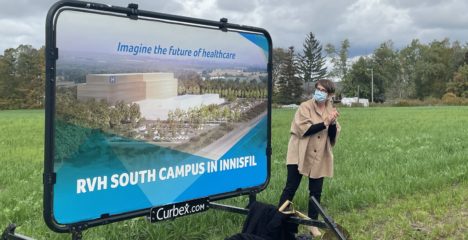
While TEAM RVH focused on our pandemic response, we also kept our eyes on an exciting future.
In fact, the pandemic crystalized the critical importance of ensuring there are enough health beds and services to care for people for generations to come. Prior to the pandemic, RVH had already set its sights 20 years into the future to guarantee the residents of Barrie, Innisfil, South Simcoe County and the surrounding areas have the care they need, when they need it.
RVH is seeking provincial government approval for its ‘one system; two site’ capital plan. It will see the current North Campus on Georgian Drive double in size, while developing a new South Campus in in Innisfil at Yonge Street and Innisfil Beach Road.
“The timelines for developing a hospital are long and complex with a five-stage provincial planning process,” says Janice Skot, RVH President and CEO. “We know the need is now and we are working closely with the province and the Town of Innisfil to get shovels in the ground, and bring care – and jobs – to south Simcoe County as soon as possible.”
RVH’s South Campus plans will evolve over the next two decades. The first phase will be a Health Hub built in ten years, focusing on outpatient care, including an Urgent Care Centre. It will expand over time, becoming a full-service hospital, with an Emergency Department, inpatient beds and operating rooms within 20 years. At maturity, the South Campus will be approximately the size of the current North Campus on Georgian Drive, seeing 350,000 patient visits each year.
The North and South Campus are completely interdependent; one can’t proceed without the other. Services within the two-campus plan are integrated, not duplicated.
Stakeholder engagement has been foundational to RVH’s planning and, over the past three years, the health centre has logged an unprecedented 83,000 consultation interactions. RVH’s goal was to ensure residents throughout every corner of the region had a voice in its expansion plans and used a wide variety of engagement tools to consult with stakeholders, including, Indigenous partners and environmental groups, vulnerable populations, partners and patients.
“Community engagement and support is critical to our planning process,” says Skot. “RVH will continue to engage all our stakeholders and partners as we work together to increase access to care in our region.”
Visit rvhplanourfuture.ca for all the latest information.
